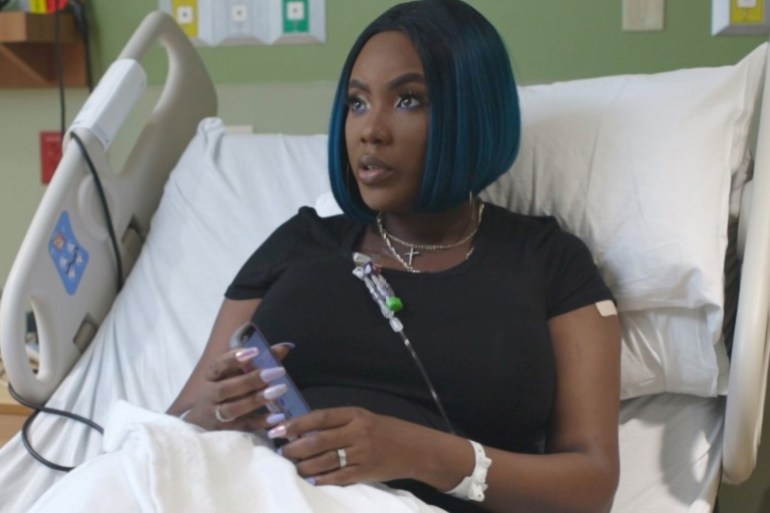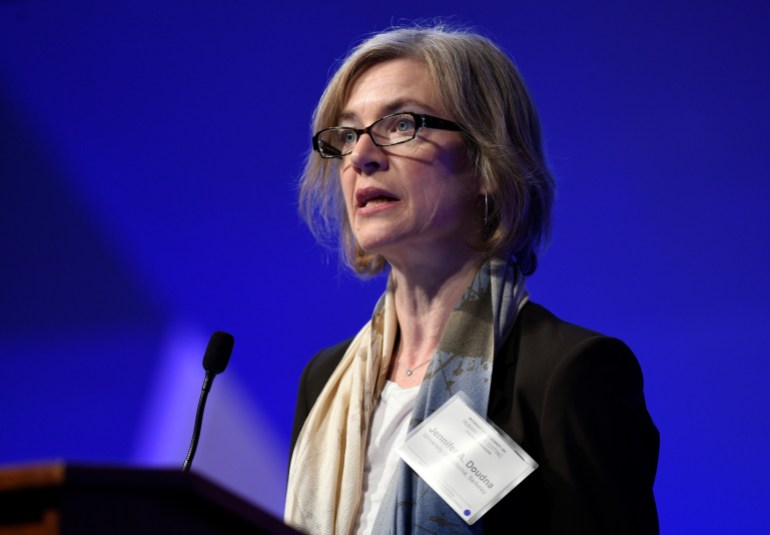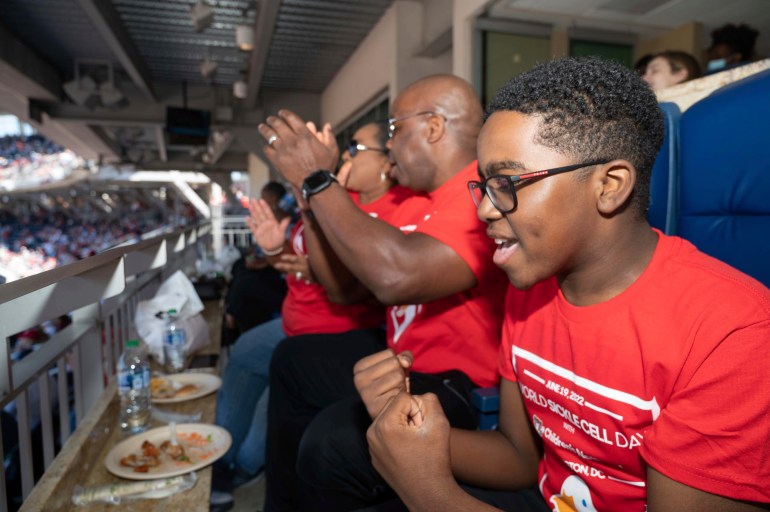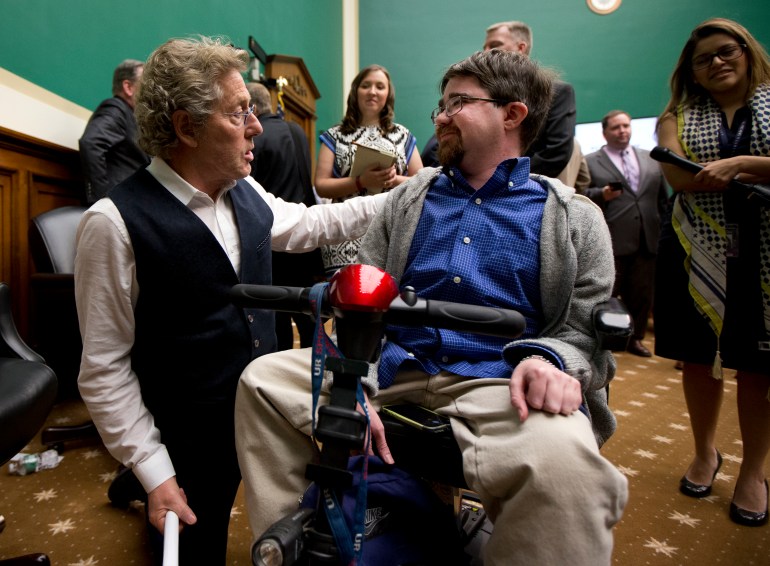Can gene editing kill deadly diseases?
Powerful new tools could turbocharge gene replacement therapies, but questions over ethics, safety and costs remain.

Two clinics sit adjacent to one another in a new hospital in a medium-sized city in the developed world.
In one, a family waits for a long-scheduled appointment. Their daughter suffers from a rare inherited disease. One of her genes encodes for a protein that doesn’t perform its functions normally, and her degenerative ailment is most likely fatal. Their doctor is about to discuss a procedure that will remove cells from the affected organ, correct the inherited faults and reinfuse her cells, allowing her organ to perform its functions without the inborn errors that she and her family have been managing since her birth.
The procedure is expensive, requiring a payment plan over a decade financed by a start-up, and it will need chemotherapy and a hospital stay. But it’s a one-time fix, and if side-effects appear down the line, doctors will study them.
In another waiting room, a soon-to-be-expectant couple waits to meet a geneticist. The doctor will present a plan for their unborn baby: to alter a few lines of its DNA to reverse a rare disorder before it even starts and prevent it from being passed to their grandchildren. Both parents carry the recessive gene that causes the disease, but because of the opportunity to correct it after fertilisation, they decide to try to get pregnant. It’s supercharged IVF.
Both of these scenarios are cutting-edge and experimental.
The first is being tried around the world and has seen some breathtaking achievements. In the United States, more than two dozen such gene-editing therapies have been approved to tackle blindness, rare immune and genetic disorders, and some cancers. But they remain expensive and tailored to the very, very few.
The second has been condemned. In-embryo edits – changes that would be replicated into reproductive cells and passed to future generations – are banned by many governments.
But either, or both, could become more common in the coming years. In March, scientists, genetics entrepreneurs, ethicists and policymakers pondered the future of the sector at the third International Summit of Human Genome Editing at the Royal Society in London.
It was on the same stage that a scientific scandal hit global headlines in 2018 when Chinese geneticist He Jiankui announced he had altered the DNA of the embryos of twin girls to protect them from an HIV infection in the future. He brought the embryos to term, was called “Dr Frankenstein” by some and sentenced to three years in prison by a Chinese court.
His revelation served as a curtain-raiser to a new era in which the codes that make our bodies can be edited. Work to correct genetic diseases has continued bounding forward.
So what’s next in the field of gene editing? Could it eliminate rare diseases previously believed to be almost incurable? And how safe will such treatments be?
The short answer: Although some gene-editing therapies are already available, a new generation of tools could turbocharge the search for cures to inherited diseases. But making gene-editing treatments affordable and accessible to more than a few patients remains a challenge, and critical ethical and safety-related questions still need answers.

The coming ‘cures’
Hundreds of new trials to correct faults in the human genome are under way. Victoria Gray, who stood before the assembled scientists and policymakers in London last month to tell her story, is among the first people ever to have been effectively “cured” of sickle cell anaemia. This genetic disease affects millions of people in the world, mostly in Africa and the United States.
The disease emerges from a single mutation in the human DNA and can shorten life expectancy by decades. Therapies for sickle cell disease have not progressed much in years, and patients still look to painkillers, antibiotics and dietary supplements to manage their pain. The first “cure” by genome editing is expected to be approved by the US Food and Drug Administration in the next several months. Gray had participated in a clinical trial for this treatment.
It will join a growing number of radical new treatments for serious and rare diseases, but these therapies often cost millions of dollars and bring unknown risks that healthcare systems are only just beginning to contemplate.
Fyodor Urnov leads a research centre in Berkeley, California, called the Innovative Genomics Institute. Its scientists are developing treatments for dozens of such illnesses that were until recently thought to be only manageable, including genetic degenerative blindness, blood disorders that slow the body’s ability to nourish itself and inherited cystic fibrosis that blocks the functioning of the lungs.
The institute uses CRISPR, a genomic editing tool that combines genetic fragments with powerful proteins to find and alter targets on the human genome precisely.
Urnov said he is optimistic that he and other researchers will soon treat the rarest of diseases, yet he maintains a pragmatic, almost cautious approach to deploying these cutting-edge tools.
“I don’t want to simplify things too much. Building a clinic-grade CRISPR [medicine] is a lot of work,” he told Al Jazeera. “But it’s not five years.”
He believes it is coming sooner – despite the challenges.
“In the US, a company recently stopped a [gene therapy drug] trial because there were only 300 patients in [the trial],” he said in an interview via Zoom. “Well, that’s unfortunate, but what should we do for a disease that has 20 people in it?”
Twenty people is not a profitable goal for a large biotech company, but it’s exactly the type of challenge Urnov’s group aspires to meet. He envisions a treatment protocol for rare, serious diseases that can be prepared for individual children.
“Our vision, our dream is [that in] major teaching hospitals … there would be a CRISPR cure centre where physicians would see a child,” he said. “The child’s DNA would be read, professional geneticists would see what causes that disease and [the] CRISPR cures group would be like a rapid response team. They would jump on it.”

‘You cannot unedit’
This vision is not yet reality and won’t be until several technological and regulatory hurdles are crossed.
Not all genetically inherited diseases can be attacked equally. Sickle cell anaemia lurks in the bone marrow, where red blood cells are made. The patient’s bone marrow can be removed, its cells edited, the remaining cells cleared and corrected stem cells replenished into the body. Blindness in retina cells in the eye can be reached by eye injection (and eventually even an eye drop).
But reaching cells in the brain or in muscle is more challenging although progress is being made quickly. And while most gene therapies have been delivered by modified viruses, which are machines tuned by evolution to find and alter a host’s genome, new methods of delivery by small particles are on the horizon.
Gene therapies require a rethink of the role of medicine. Most are one-time infusions or extractions that alter the way a body makes cells, and they last for a lifetime. “This keeps us all awake at night,” Urnov said. “Once you have edited someone, you cannot unedit them.”
This is why Urnov and many other researchers insist that genetic intervention therapies must be reserved for very specific conditions. “CRISPR is not ready to treat chronic conditions that currently can be managed with existing medication,” he said. “The place for CRISPR is … a devastating disease for which there are no therapeutic options.”
Urnov said the “longest window of time” through which people who have received CRISPR interventions have been observed is just over three years. “Is it possible that three years from now that person will develop something? It is,” he said. Patients who receive the newest generations of genetic therapies will likely be monitored by doctors for decades.
There are other ethical issues at play too.
The highest burden of sickle cell disease, for instance, is in Africa, which is also where the newest treatments are likely to arrive last. Melissa Creary, a bioethicist at the University of Michigan, studies equity and ethics through the lens of this disease.
“People are open to the promise of the technology of gene editing, but there’s still scepticism for some because we don’t know longitudinally what it means for people who live with sickle cell disease to go through this process,” she said.
That concern comes in part from a history of discriminatory healthcare practices.

Acknowledging ‘systemic oppression’
In the US, sickle cell patients are disproportionately Black, and the burden of the disease is high, costing health systems millions of dollars over the person’s lifetime and countless years of lost productivity.
A novel cure reveals unresolved questions. “We have to ask why there’s been such a long amount of neglect for such a large amount of people [for] such a debilitating disease,” Creary said. “It really is wound up in notions of exclusion, structural racism and how healthcare systems operate, how research infrastructures operate, how the scientific endeavour operates.
“It’s [about] more than providing a scientific intervention. It’s about looking more widely at these structures of systemic oppression that have occurred for generations for this population.”
The first potential sickle cell disease cure is likely to reach tens of thousands of patients in the US and Europe. While that’s a significant number, it’s a fraction of the about 100,000 people just in the US who suffer from the condition. Globally, more than 300,000 babies are born with serious blood disorders like sickle cell anaemia and beta thalassemia every year, most of them in Africa.
The treatment is also likely to be expensive. These are one-time cures for diseases that will otherwise cost patients and health systems several million dollars over a lifetime. “We want to really pay attention as these technologies are being developed, as they’re getting closer to market, about how we are considering the populations at hand that have access or don’t have access to these technologies,” Creary said.
One way to improve access to such therapies beyond the rich world might be to learn from the lessons of COVID-19, said Ambroise Wonkam, a Cameroonian doctor.
Wonkam heads a pan-African research effort, H3Africa, which is building a database of genetic information from – and for – people who live on the world’s most genetically diverse continent. One of H3Africa’s goals is to identify the genetic targets that will fit the tailored medicines of the near future.
“When COVID-19 shut down the whole world, no one would imagine we would develop a vaccine based on a genomic sequence, an mRNA vaccine, and deliver across the world,” Wonkam told Al Jazeera. “I can only imagine that if we have a similar programme, a really large programme that includes not only research but also equity, we could accelerate access the way COVID-19 access was done in weeks.”
That equity has previously been lacking. Africa had to wait too long for COVID-19 vaccines as shortages continued despite surplus stock in the Global North. Yet three years into the pandemic, mRNA-vaccine-making hubs have been launched in six countries in Africa to respond to future needs.
“We need the political will. We need the policy. We also need a massive investment to allow it to happen,” Wonkam said. “When? That will be difficult to say.”
At present, many gene-editing regimes for sickle cell and other diseases are done ex vivo, or outside the body, in facilities run by specialists. Human cells are removed, edited and replaced. As in vivo – inside the body – techniques are refined, in which a one-time infusion or shot corrects a faulty gene, the technology could be scaled up and delivered to more recipients. Charitable groups like the Bill and Melinda Gates Foundation and the Global Gene Therapy Initiative are supporting research towards in vivo techniques for curing blood disorders and mitigating the burden of HIV infection.

What the future holds
Although only one CRISPR-based therapy is in front of American regulators at the moment, there are thousands of rare genetic diseases that could be targeted with CRISPR or similar methods, and millions of potential patients could benefit.
And approval of the sickle cell therapy could speed up progress towards treatments for these other diseases, Wonkam said.
Still, that momentum carries its own risks, including creating public expectations that might be unreasonable.
Kevin Flanigan, a practicing neurologist and researcher, sees an end to inherited muscular disorders. Flanigan’s clinic and laboratory in Columbus, Ohio, treats patients with Duchenne muscular dystrophy (DMD), a devastating genetic disease. It affects mostly boys and causes muscles to deteriorate from an early age, leading to serious complications. It is also a target for new interventions by gene therapies, including but not limited to CRISPR, to correct the inherited genetic code that causes a vital muscular protein to form incorrectly.
Some of the genetic interventions that Flanigan’s team is working on will not reach the trial stage for several years, but that doesn’t mean its patients don’t ask for them. “Candidly, one challenge is managing expectations,” he told Al Jazeera. “We have families who come in and say, ‘I want CRISPR,’ as if it’s one thing, or ‘I don’t want a standard therapy because I’m waiting for CRISPR.’”
“What physicians view as CRISPR is many different ways that you restore function or change function to genes,” he said, “and we have to do a lot of education to explain the range of options there.”
That, Flanigan said, is a key part of what his clinic does. “Any parent with a child with DMD is washed with a firehose of information about genetics, about splicing, about protein, so we spend a fair amount of time on education and management of expectation,” he said.
Flanigan’s team tackles a thorny scientific challenge too. Muscle is about half of a human’s body mass. That’s “an enormous number of [cell] nuclei we have to get into” with any potential gene-editing therapy, he pointed out. And the gene that his team is aiming to correct is one of the largest in the human genome: 2.4 million base pairs on the X chromosome.
“How much we have to target, it’s not clear,” Flanigan said. And it’s not clear whether therapies could be done on cells outside the human body. But Flanigan is optimistic: “I’m very hopeful we will reach meaningful therapies that have longstanding benefits to patients.”

‘Not beholden to DNA misspellings anymore’
At the moment though, there’s a bit of the Wild West to the gene-editing landscape.
Many beneficiaries of these cutting-edge medicines have been part of academic trials conducted in partnerships with drug companies to receive life-changing cures with the financial help of large institutions.
Others have developed trials for themselves or their family members. Families have raised enormous funds to treat their children. And safe, successful results are far from guaranteed. In 2022, two young people died after receiving a multimillion-dollar treatment for the fatal disease spinal muscular atrophy due to a known side-effect of the drug.
Drug companies, insurers and regulators do not yet have clear models for how to price one-time cures that cost immense sums and serve small sets of patients, and drugs have been pulled from markets after facing uncertainty over how to sell them.
Most scientists insist that the field is simply not ready for some of the more far-reaching approaches that in theory are possible – like the scenario of a family asking to edit an embryo to correct a genetic fault and prevent a disease before it starts.
“Embryo editing is not just jumping into a swimming pool without knowing it has water,” Urnov said. “It’s doing so blind-folded, head down, with nobody watching.
“The risks that are already known that we cannot mitigate are so severe that to even tempt human beings with this idea, it’s unethical,” he said.
Those dangers are manifold: How does one gene function across the many stages of development as a zygote transforms into a child? How does it function over a lifetime? What if an edit misses its target? What if some cells are affected while others are not? By the time negative downstream effects are noticed, after a few cells became trillions, would it be too late to intervene?
“We’re tempting our fellow human beings with not just something untested, with something that’s unnecessary and where the risks extraordinarily outweigh the potential benefits,” Urnov said.
Indeed, as new treatments emerge – and previously untreatable conditions can be cured – those risks might be unnecessary.
At the International Summit of Human Genome Editing in London, it was revealed that a 13-year-old named Alyssa had been virtually free from a fatal, rare leukaemia for a year after her immune cells were treated with a new gene therapy.
As David Liu, a chemist and evolutionary biologist who heads a Harvard University-linked genetics institute in Massachusetts, described it to the conference, the work is ushering in a new age – one in which “we’re no longer so beholden to the misspellings in our DNA.”